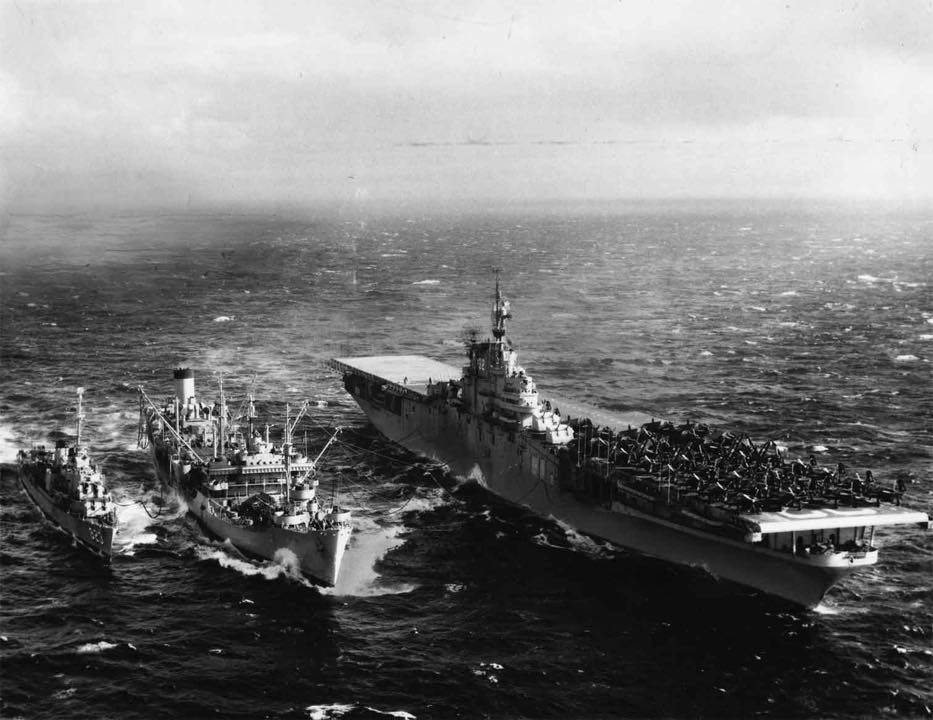
Displacement: 27,100 tons; length: 888 feet; beam: 147½ feet; draft: 28 feet 7 inches; speed: 33 knots; complement: 3,448 crew; armament: 12 5-inch guns, 72 40mm guns; aircraft: 80+; class: Essex
The third Leyte was laid down as Crown Point (CV-32) by Newport News Shipbuilding and Dry Dock Co., Newport News, Va., on 21 February 1944; renamed Leyte on 8 May 1945; launched on 23 August 1945, sponsored by Mrs. James M. Mead; and commissioned on 11 April 1946, Capt. Henry F. MacComsey in command.
Leyte joined USS Wisconsin (BB-64) on a goodwill cruise down the western seaboard of South America in the fall of 1946 before returning to the Caribbean on 18 November to resume shakedown operations. The following three years were spent in numerous fleet exercises in the Atlantic and Caribbean, training naval reservists, and four deployments in the Mediterranean: April to June 1947, July to November 1947, September 1949 to January 1950, and May to August 1950. The latter included a demonstration of air power over Beirut, Lebanon, on 13 August, supporting the Middle East against Communist pressure. Leyte returned to Norfolk on 24 August, and after two weeks of preparation, departed on 6 September 1950 to join TF 77 in the Far East to support United Nations Forces in Korea.
Leyte arrived at Sasebo, Japan, on 8 October 1950 and made final preparations for combat operations. From 9 October through 19 January 1951, the ship and her aircraft spent 92 days at sea and flew 3,933 sorties against the North Korean aggressors.
On 4 December 1950, Ensign Jesse L. Brown, the Navy's first black pilot, flying a close support mission from Leyte, was forced to make a crash landing near Hagaru-Ri when his plane was hit by enemy ground fire. Observing that Ens. Brown was unable to get out of his cockpit, one of his squadron mates, Lt. (j.g.) Thomas J. Hudner, fearlessly landed to assist. Ens. Brown died before he could be removed from the wreckage. Lt. (j.g.) Hudner was rescued by helicopter and later was awarded the Medal of Honor. Ens. Brown was posthumously decorated with the Distinguished Flying Cross.
All told, Leyte's pilots accumulated 11,000 hours in the air while inflicting massive damage upon enemy positions, supplies, transportation, and communications. Leyte returned to Norfolk for overhaul on 25 February 1951.
After fleet training exercises in the Caribbean terminated on 21 August 1951, the carrier departed for her fifth tour of duty with the 6th Fleet on 3 September. She returned to Norfolk on 21 December for operations out of Hampton Roads, and again steamed for the Mediterranean on 29 August 1952. Reclassified CVA-32 on 1 October 1952, she returned to Boston on 16 February 1953 for deactivation. On 8 August, however, she was ordered to be retained in the active fleet, and, redesignated CVS-32 on the same day, work was begun converting her to an ASW support carrier.
On 16 October 1953, at 1515, while still under conversion to an antisubmarine carrier, Leyte suffered an explosion in her port catapult machinery room. Within minutes, naval base and city fire trucks were on the scene. After a hard and gallant fight, the fire was extinguished at 1957. As a result of the fire, 37 men died and 28 were injured.
Conversion completed on 4 January 1954, Leyte departed Boston for Quonset Point, R.I., as the flagship of CarDiv 18. She conducted anti-submarine operations in the Atlantic and Caribbean over the next five years. She also served briefly as an interim amphibious assault ship in 1957, with her normal air group replaced with Marine Corps transport helicopters.
Leyte departed Quonset Point in January 1959 for the New York Navy Yard where she commenced pre-inactivation overhaul. She was redesignated AVT-10 and decommissioned both on 15 May 1959, and was assigned to the Philadelphia group of the Atlantic Reserve Fleet with a berth in New York. The ship was stricken from the Navy List on 1 June 1969, and was sold for scrapping in September 1970. Leyte received two battle stars for Korean service.
